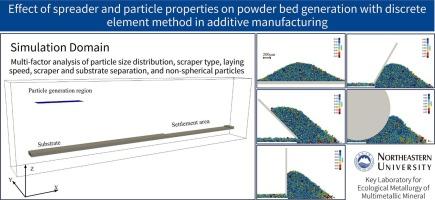在增材制造中使用离散元素法时,撒布器和颗粒特性对粉末床生成的影响
IF 4.5
2区 工程技术
Q2 ENGINEERING, CHEMICAL
引用次数: 0
摘要
提高粉末床的质量可以显著降低激光粉末床熔融技术制造的成品中的缺陷。在这项工作中,使用离散元法研究了粒度分布、刮刀类型、铺设速度、刮刀与基底分离以及非球形颗粒等多因素的影响。结果表明,辊筒形成的粉床可以容纳最多的颗粒,最大间隙为 67.64%。刮刀角度会对沉积颗粒的力和体积产生重大影响。加快铺放速度会加剧粉末的扰动,增加对刮刀的冲击。非球形颗粒对颗粒大小的影响较小,这增加了对刮刀的推力和频率以及颗粒之间的摩擦。此外,细长颗粒对流动性的影响最大。本文章由计算机程序翻译,如有差异,请以英文原文为准。

Effect of spreader and particle properties on powder bed generation with discrete element method in additive manufacturing
Enhancing the quality of the powder bed can significantly lower the defects in the finished product manufactured by Laser-based powder bed fusion. In this work, the multi-factor effects of particle size distribution, scraper type, laying speed, scraper and substrate separation, and non-spherical particles were investigated using the discrete element method. The results show that the powder bed created by the roller can hold the largest number of particles, with a maximum gap of 67.64 %. The scraper angle will significantly impact the force and volume of the deposited particles. Accelerating the laying speed worsens the powder disturbance and raises the impact on the scraper. Non-spherical particles have less effect than particle size, which raises the force and frequency of pushing on the scraper and the friction between the particles. In addition, the slender particles have the most significant impact on the fluidity.
求助全文
通过发布文献求助,成功后即可免费获取论文全文。
去求助
来源期刊

Powder Technology
工程技术-工程:化工
CiteScore
9.90
自引率
15.40%
发文量
1047
审稿时长
46 days
期刊介绍:
Powder Technology is an International Journal on the Science and Technology of Wet and Dry Particulate Systems. Powder Technology publishes papers on all aspects of the formation of particles and their characterisation and on the study of systems containing particulate solids. No limitation is imposed on the size of the particles, which may range from nanometre scale, as in pigments or aerosols, to that of mined or quarried materials. The following list of topics is not intended to be comprehensive, but rather to indicate typical subjects which fall within the scope of the journal's interests:
Formation and synthesis of particles by precipitation and other methods.
Modification of particles by agglomeration, coating, comminution and attrition.
Characterisation of the size, shape, surface area, pore structure and strength of particles and agglomerates (including the origins and effects of inter particle forces).
Packing, failure, flow and permeability of assemblies of particles.
Particle-particle interactions and suspension rheology.
Handling and processing operations such as slurry flow, fluidization, pneumatic conveying.
Interactions between particles and their environment, including delivery of particulate products to the body.
Applications of particle technology in production of pharmaceuticals, chemicals, foods, pigments, structural, and functional materials and in environmental and energy related matters.
For materials-oriented contributions we are looking for articles revealing the effect of particle/powder characteristics (size, morphology and composition, in that order) on material performance or functionality and, ideally, comparison to any industrial standard.
 求助内容:
求助内容: 应助结果提醒方式:
应助结果提醒方式:


